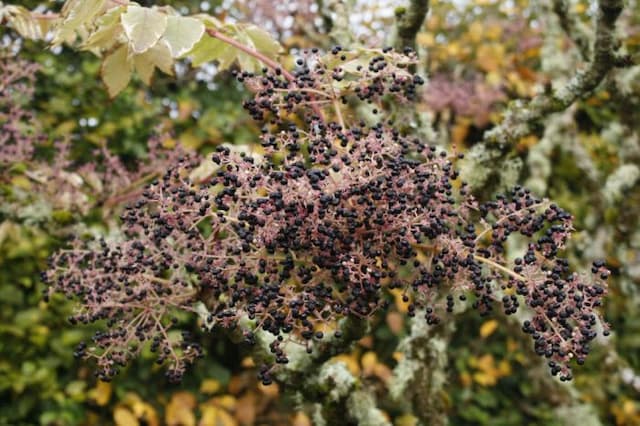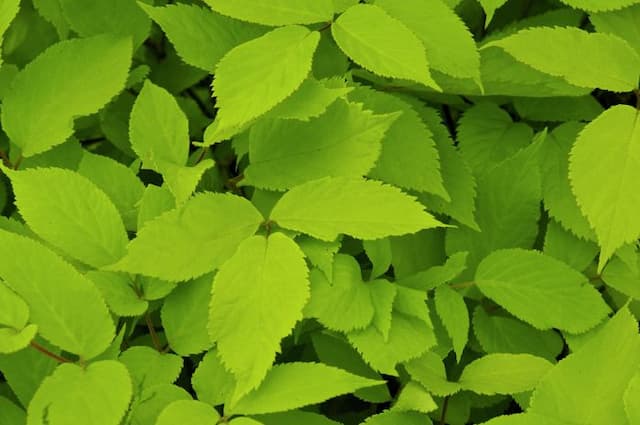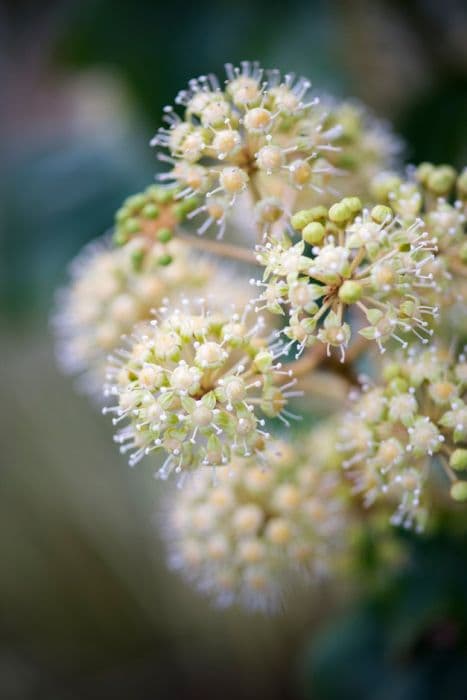English Ivy Hedera helix 'Buttercup'

ABOUT
The English Ivy 'Buttercup' is a climbing evergreen plant that is marked by its distinct foliage. Each leaf is lush, showcasing a bright, almost luminous, golden-yellow color in full sun which can become more of a pale green when the plant is in shade. The leaves have prominent veins and a glossy surface that catch the light, giving the plant a shiny appearance. The shape of the leaves is roughly triangular with a heart-shaped base, and they possess a slightly lobed to wavy edge. They are arranged alternately along the slender, trailing vines. The 'Buttercup' variety of English Ivy has the ability to cling to surfaces with small rootlets along its vines. Typically, the younger leaves on the plant are more brightly colored, while mature foliage may have a deeper green shade, often with yellow tones. The overall aesthetic of the 'Buttercup' is one of vibrant gold foliage that adds luminosity to spaces where it grows.
About this plant
 Names
NamesFamily
Araliaceae
Synonyms
English Ivy, Common Ivy, European Ivy
Common names
Hedera helix 'Buttercup'.
 Characteristics
CharacteristicsLife cycle
Perennials
Foliage type
Evergreen
Color of leaves
Variegated
Height
6-9 feet (1.8-2.7 meters)
Spread
3-6 feet (0.9-1.8 meters)
Plant type
Climber
Hardiness zones
5-11
Native area
Europe
Benefits
 General Benefits
General Benefits- Ornamental Value: Adds vibrant greenery and visual interest to gardens and interiors with its variegated golden-yellow and green leaves.
- Versatility: Can be grown in a range of environments, from indoors in pots to outdoors as ground cover or climbing walls.
- Low Maintenance: Requires minimal care once established, making it suitable for beginners or busy gardeners.
- Durability: Tolerant of a wide range of conditions including poor soil, drought, and shade.
- Seasonal Interest: Evergreen nature provides year-round color and texture to the landscape.
- Wildlife Habitat: Provides shelter and sometimes food for birds and insects.
- Erosion Control: Helps stabilize soil in landscape areas prone to erosion.
 Medical Properties
Medical Properties- Expectorant: Used traditionally to help clear mucus from the respiratory tract.
- Antispasmodic: May reduce spasms in muscles, particularly those associated with coughs.
- Anti-inflammatory: Contains compounds that may help reduce inflammation.
- Antimicrobial: Exhibits properties that may inhibit the growth of certain bacteria and fungi.
 Air-purifying Qualities
Air-purifying QualitiesThis plant is not specifically known for air purifying qualities.
 Other Uses
Other Uses- Hedera helix 'Buttercup', commonly known as English ivy, can be used to create a natural dye. The leaves of the plant, when boiled, can impart a range of colors from green to yellow on wool and other natural fibers.
- English ivy can be used in topiary gardens. Trained to grow on frames, it can be shaped into various forms like animals or geometric designs.
- The dense cover provided by English ivy can be used for hiding unsightly features in the garden, such as old stumps or chain-link fences.
- Decorative crafts: The vines of English ivy can be woven into wreaths or used in other decorative crafts for a touch of nature indoors.
- Photography backdrops: Lush growth of English ivy can serve as an attractive green backdrop for portrait photography.
- Living curtains: English ivy can be grown indoors in hanging pots to create a curtain of greenery, adding privacy and a unique aesthetic to a space.
- Natural cooling: When planted on the exterior walls of buildings, English ivy can help keep the structure cool by blocking direct sunlight.
- Erosion control: In large outdoor areas, English ivy can be planted to help stabilize soil and prevent erosion on slopes.
- Labyrinth gardens: English ivy can be used to outline paths in a labyrinth garden, providing a meditative space that stays green year-round.
- Christmas decor: English ivy can be incorporated into holiday decorations, such as Christmas garlands, due to its evergreen nature and association with traditional winter festivities.
Interesting Facts
 Feng Shui
Feng ShuiThe English Ivy is not used in Feng Shui practice.
 Zodiac Sign Compitability
Zodiac Sign CompitabilityThe English Ivy is not used in astrology practice.
 Plant Symbolism
Plant Symbolism- Connection: English Ivy, including the 'Buttercup' cultivar, is often associated with connection and friendship due to its tendency to cling and grow along structures and other plants.
- Eternity: The evergreen nature of English Ivy symbolizes eternity and everlasting life, which is why it's occasionally found in religious contexts and at funerals.
- Fidelity: Given its clinging growth habit, English Ivy is sometimes seen as a symbol of fidelity and loyal affection in relationships.
- Protection: Historically, English Ivy was believed to protect against negative energies and spirits, leading people to plant it around their homes.
- Survival and Resilience: Its ability to thrive in challenging conditions symbolizes survival, resilience, and the ability to overcome adversity.
 Water
WaterEnglish Ivy, specifically the 'Buttercup' variety, should be watered thoroughly when the top inch of soil feels dry to the touch. This typically means watering about once a week, but this can vary depending on the environmental conditions. When watering, add enough water so that it runs out of the drainage holes, indicating the soil has been saturated. For an average-sized pot, this might mean using about 1 gallon of water every 7 to 10 days, but always adjust based on your plant's response and the current season, watering more sparingly during winter months.
 Light
LightEnglish Ivy 'Buttercup' prefers bright, indirect light but can also tolerate partial shade. Avoid direct sunlight as it can scorch the leaves. The ideal spot would be near a window that gets plenty of light, but with some sort of sheer curtain or shade to diffuse the direct rays.
 Temperature
TemperatureEnglish Ivy thrives in a temperature range between 50 to 70 degrees Fahrenheit. It can survive short periods in temperatures as low as 10 degrees Fahrenheit and as high as 90 degrees Fahrenheit. The ideal conditions for 'Buttercup' would be consistently maintained within the preferred temperature range to encourage healthy growth.
 Pruning
PruningPruning English Ivy 'Buttercup' is important for maintaining its shape, encouraging bushier growth, and removing any dead or damaged leaves. Prune as needed throughout the year, with the best time being early spring before new growth starts. Lightly trim the plant to keep it within bounds and cut back any excessively long vines to promote fuller growth.
 Cleaning
CleaningAs needed
 Soil
SoilThe English Ivy 'Buttercup' thrives in a soil mix of equal parts peat moss, perlite, and potting soil, creating an airy, well-draining foundation. The ideal soil pH for English Ivy 'Buttercup' should be slightly acidic to neutral, around 5.5 to 7.0.
 Repotting
RepottingEnglish Ivy 'Buttercup' should be repotted every two to three years or when it outgrows its pot, to prevent root crowding and to replenish its soil nutrients.
 Humidity & Misting
Humidity & MistingEnglish Ivy 'Buttercup' prefers moderate to high humidity levels, ideally between 40% and 60%, to maintain its lush foliage and support growth.
 Suitable locations
Suitable locationsIndoor
Place English Ivy 'Buttercup' in bright, indirect light and maintain humidity.
Outdoor
Grow in shaded areas, protect from direct sun and harsh elements.
Hardiness zone
5-11 USDA
 Life cycle
Life cycleCommonly known as Buttercup English Ivy, the life of Hedera helix 'Buttercup' begins as a seed, which germinates in moist, shaded soil. The seedling develops into a juvenile form with lobed, trailing leaves that enable it to climb and spread as a groundcover. As it matures, it adheres to surfaces with aerial rootlets and develops woody stems. During the adult stage, the foliage changes to unlobed leaves, and the plant becomes capable of producing small, umbrella-shaped clusters of greenish-white flowers. Following pollination, these flowers develop into small, black, berry-like fruits, which are eaten and dispersed by birds. The plant continues to grow and spread, potentially developing into a dense mat of foliage over time, and can live for several years unless conditions become unfavorable.
 Propogation
PropogationPropogation time
Spring-Early Summer
The Hedera helix 'Buttercup', commonly known as English Ivy, is most effectively propagated through stem cuttings. To propagate English Ivy, select a healthy stem and cut a piece approximately 4-6 inches (10-15 cm) in length using a clean, sharp pair of scissors or gardening shears. Ensure the cutting has several leaves, and remove the lower leaves to expose a few nodes where the roots will grow. The cuttings can then be placed in water to encourage root development, or they can be potted directly into a soil mix. If rooting in soil, insert the cut end into a pot filled with moist potting mix and cover the pot with plastic to maintain high humidity until the cutting has rooted, which typically takes a few weeks. Keep the soil consistently moist and place the cutting in bright, indirect light. Once the cutting has rooted, which can be checked by gently tugging on the plant to feel for resistance, it can be transitioned to normal care conditions.









